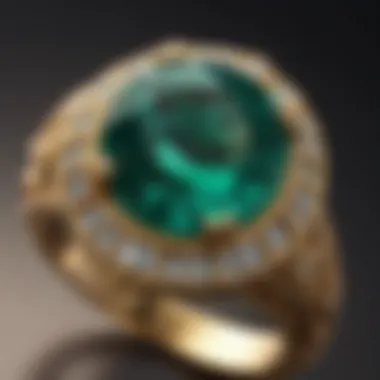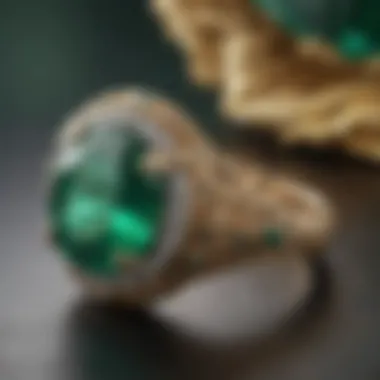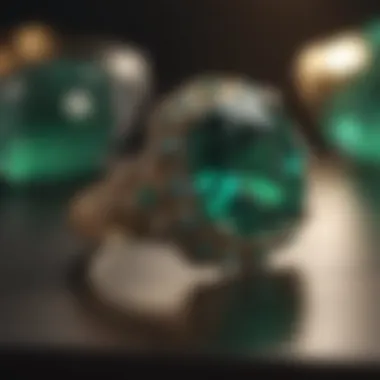Understanding the Cost of Emerald Rings Today


Intro
Emerald rings have captivated hearts for centuries. Their rich, vibrant green shades and historical significance make them a sought-after addition to any jewelry collection. Understanding the cost of an emerald ring requires a multifaceted approach. Buyers need to consider various elements that contribute to pricing and value. This guide aims to unravel the complexities surrounding emerald rings and shed light on what buyers should know before making a purchase.
Gemstone Overview
Definition and Characteristics
Emeralds are a variety of the mineral beryl, colored green by trace amounts of chromium and sometimes vanadium. These gemstones are renowned for their stunning appearance and unique inclusions, often referred to as "jardin". The ideal emerald displays a vivid green hue with good clarity and brilliance. Natural emeralds typically have some inclusions, which can affect their value, but many buyers appreciate these imperfections as they enhance the stone's character.
Classification of Gemstones
When classifying gemstones, several key criteria must be discussed, including:
- Natural vs. Synthetic: Natural emeralds are mined directly from the earth, while synthetic emeralds are lab-created. The prices of these two can differ significantly.
- Grading Systems: Emeralds are graded based on clarity, color, and cut. A higher quality gemstone commands a higher price.
- Geographical Origin: Emeralds from Colombia, particularly those from the Muzo and Chivor mines, are often considered the most valuable. Other sources include Zambia and Brazil, but the quality may vary.
Emeralds are classified into several categories based on these criteria. Understanding these classifications helps buyers feel confident in their purchasing decisions.
Historical Significance
Ancient Uses and Cultural Importance
Emeralds have held a place of honor in various cultures across the ages. Ancient Egyptian royalty wore emeralds as symbols of fertility and rebirth. In the Inca Empire, emeralds were considered sacred, often reserved for royals. Their historical importance goes beyond mere beauty; they have been believed to provide protection and good fortune.
Myths and Legends Surrounding Gemstones
Numerous myths surround emeralds, adding to their allure. One legend posits that emeralds can promote creativity and enhance memory. Another belief is that emeralds can protect against evil spirits. These stories have been passed through generations, enriching the gemstone's value in the eyes of many collectors.
"Emeralds have been cherished throughout history, symbolizing love and rebirth in various cultures."
Understanding the historical significance of emeralds aids in appreciating their worth beyond the marketplace. The cultural narratives intertwined with this gemstone only serve to enhance its appeal.
In summary, this guide delves into the many facets that influence the cost of emerald rings. From the intrinsic characteristics of the gemstone to the historical narratives that shape public perception, potential buyers can gain a more comprehensive understanding of what makes an emerald ring truly valuable.
Understanding the Basics of Emeralds
Understanding emeralds is essential for anyone looking to buy, sell, or appreciate these gemstones. Knowing the foundational elements will enhance your comprehension of their value and significance in jewelry. Emeralds are not just beautiful; they are also symbols of wealth, love, and luxury. This section will dissect crucial aspects such as definitions, characteristics, and different types of emeralds to provide a solid groundwork for further exploration of costs and market dynamics.
Definition and Characteristics
Emeralds are a variety of the mineral beryl, colored by trace amounts of chromium and sometimes vanadium. This rich green hue makes them highly sought after. They are usually translucent and can have inclusions, which are natural imperfections found within the gemstone. These characteristics play a significant role in determining the overall value of an emerald. The green color is the defining element of its appeal, but clarity and cut also matter considerably. An emerald’s quality is measured against established grading criteria, enhancing its allure in the marketplace.
Types of Emeralds
Emeralds can be broadly categorized into three types based on how they are created and their origin. Understanding these types helps in evaluating their pricing and desirability.
Natural Emeralds
Natural emeralds are formed deep within the earth under specific geological conditions. The rarity of these stones significantly contributes to their value. The key characteristic of natural emeralds is their unique inclusions, often referred to as "jardin". These inclusions can enhance their charm but may also lower their clarity. Natural emeralds generally command higher prices in the market due to their scarcity and desirability. A buyer can appreciate their originality and history, as each stone tells a unique story. They also often boost a collector's reputation due to their authenticity.
Lab-Created Emeralds
Lab-created emeralds mimic the appearance of natural emeralds but are made in a controlled environment. These gems are chemically and physically identical to their natural counterparts. The primary advantage of lab-created emeralds is their cost-effectiveness. They are usually more affordable without losing aesthetic appeal. This makes them a popular option for consumers who want the look of an emerald without the hefty price tag. However, some purists argue that they lack the soul and heritage of natural emeralds.
Synthetic vs. Natural
The distinction between synthetic and natural emeralds is critical in understanding the overall market for these gemstones. Synthetic emeralds are made using techniques to replicate natural conditions but often do so within days instead of thousands of years. While both synthetic and natural emeralds have similar chemical properties, the synthetic ones can be produced in perfect clarity and color, making them appealing for buyers looking for an immaculate product. However, their lack of natural formation can limit their appeal among collectors. The price for synthetic emeralds is lower compared to natural ones, which reflects their differences.


Factors Influencing the Cost of Emerald Rings
The cost of emerald rings is a complex topic that encompasses various elements. Understanding these factors can be critical for anyone looking to purchase an emerald ring, whether for personal use or as an investment. The price of emeralds can vary greatly depending on several key aspects, including gemstone quality, origin, size, and more. Buyers should consider these elements carefully to make informed decisions and avoid overpaying.
Gemstone Quality and Grading
The quality of the gemstone has a direct impact on the price of the emerald ring. Quality is typically assessed based on grading criteria, which often include color, clarity, and the cut of the stone.
Color Grading
Color grading refers to the hue, tone, and saturation of the emerald. The most sought-after emeralds display a vivid green color, with little to no yellow or blue undertones. This striking hue not only makes the stone more beautiful but also significantly increases its market value.
A well-graded emerald can command a much higher price due to its rarity. Consequently, buyers should be aware of how color grading influences cost when shopping. The challenge lies in distinguishing between different grades, as subtle differences can affect price and desirability.
Clarity and Inclusion Types
Clarity speaks to the presence of internal inclusions or blemishes in the emerald. Emeralds tend to have more inclusions than other gemstones, and understanding these clarity factors is essential. The grading often classifies emeralds into categories such as “eye-clean,” “very slightly included,” and “heavily included.”
Higher clarity generally correlates with higher prices. Understanding the implications of specific types of inclusions can guide buyers toward better choices. For instance, some inclusions may not detract from the beauty or integrity of the stone, while others can significantly lower its value.
Cut and its Importance
The cut refers to how well the emerald has been shaped and polished. Although emeralds can be cut in various styles, the cut influences the stone's brilliance and how light interacts with it. A well-executed cut can enhance the visual appeal of the emerald.
Emeralds are often cut into shapes like cushion or oval for maximizing light reflection. Understanding the importance of cut is vital, as a poor one can detract from even the finest gemstone. Thus, buyers should evaluate the cut closely when assessing value.
Size and Carat Weight
Size and carat weight also significantly affect the pricing of an emerald ring. Generally, larger emeralds are rarer and can command much higher prices. This incrementally increases demand, which further drives prices up.
When purchasing, buyers must assess their budget while considering the size they desire. A larger, high-quality emerald will usually yield lots of attention, but one must also balance size with other quality factors.
Origin of the Emerald
Origin can be a decisive factor in establishing the cost. Different geographical areas are known for producing unique emerald qualities.
Colombian Emeralds
Colombian emeralds are renowned for their exceptional quality and vivid coloring. Their historical significance and distinctive appearance make them one of the most sought after. Buyers often see a marked premium for Colombian stones in the market, owing to their heritage and the limited quantity available.
Zambian Emeralds
Zambian emeralds, while less expensive than Colombian ones, offer competitive quality. They usually exhibit a slightly different color profile, often appearing more vibrant than their Colombian counterparts. This factor may appeal to buyers looking to explore alternatives without completely sacrificing quality.
Brazilian Emeralds
Brazilian emeralds present a unique option, standing out for their exceptional clarity. They may be priced lower compared to Colombian and Zambian emeralds, making them attractive to budget-conscious buyers. Their mixed qualities can lead to various price points, thus offering options for different price ranges.
Treatment and Enhancement
Emerald treatments can play a critical role in their valuation and pricing. Many emeralds undergo processes to enhance their color and clarity, which can influence the perceived value.
Common Treatments
Common treatments include oiling, which improves clarity by filling in cracks. While this treatment is widespread and accepted, it's crucial for buyers to know if a stone has been treated. Treated emeralds may come at lower prices compared to untreated counterparts, but they also carry related implications in terms of long-term care.
Impact on Value


The impact on value due to treatments can be significant. Untreated emeralds are often more valuable than treated stones due to their rarity. Understanding the treatment status of an emerald is essential for buyers, as it can dramatically shift the stone’s long-term value and price.
This section has explored multiple factors that influence the cost of emerald rings. Each aspect plays a significant role in determining the final price. Buyers need to stay informed and carefully consider each factor while shopping.
Market Trends and Pricing Dynamics
Understanding market trends and pricing dynamics is essential when considering the purchase of an emerald ring. This section investigates how broader economic factors and consumer behaviors interact with gemstone pricing. It allows potential buyers to grasp not just the intrinsic value of the emerald but also the external elements that shape its market price. Awareness of these dynamics is important as it contributes to well-informed purchasing decisions. Buyers who understand market forces often secure better deals while also ensuring they are investing in quality.
Current Market Prices
Emerald rings can vary significantly in price depending on many factors. Currently, a standard range for decent-quality emerald rings typically spans from $500 to $5,000. However, high-quality stones, especially those with excellent color and clarity, can reach much higher price points. Rare specimens can fetch prices in the tens of thousands, or even more, depending on unique attributes.
Emerald prices are influenced by their quality. As detailed earlier, color, clarity, and size play a major role. Nowadays, consumers should also consider how market trends affect the prices of emerald rings.
Factors Affecting Market Prices
Global Economic Conditions
Global economic conditions highly influence the cost structure of emerald rings. Economic stability, currency values, and trade policies are crucial elements here. When economies are strong, demand for luxury goods, including gemstones, tend to rise. This, in turn, causes prices to climb. Alternatively, during economic downturns, the luxury goods sector, including emeralds, may experience a decrease in demand, leading to lower prices. One notable characteristic is that economic conditions can drive rapid changes in the jewelry market.
For instance, during times of inflation, gemstone prices may surge as consumers turn to tangible assets as a safeguard against economic instability. Ultimately, understanding these conditions is fundamental for any gemstone enthusiast or investor.
Consumer Demand Trends
Consumer demand trends significantly shape the emerald market. As trends shift towards sustainable and ethically sourced stones, demand for responsibly mined emeralds has increased. This trend is changing how jewelers source emeralds, affecting prices.
Another important aspect is the feature of fashion cycles. Popularity in jewelry styles can spike demand for certain types of gemstones, including emeralds. These factors create a fluctuating market, making consumer understanding necessary for smart purchasing.
"Emeralds are not just timeless; they represent an evolving harmony of natural beauty and human aspiration."
Historic Trends in Emerald Pricing
Emerald pricing has fluctuated throughout history, influenced by various factors such as market demand, mining discoveries, and cultural significance. Traditionally, emeralds from Colombia were viewed as the most valuable, which still holds some merit today, though new discoveries in Zambia and Brazil have shifted some focus.
Over the decades, the increasing popularity of emeralds in fashion has led to rising prices. Overall, by examining the historical pricing, buyers can gain insights into potential future value trends that may influence their purchasing decisions.
Choosing an Emerald Ring
Selecting an emerald ring requires careful consideration. Emeralds hold a distinctive beauty and prestige among gemstones, making them popular choices for engagement rings and special occasions. Understanding how to choose an emerald ring not only aids in investment but also enhances the overall satisfaction of ownership. This section delves into key aspects to consider when selecting an emerald ring, allowing buyers to appreciate the value beyond its aesthetic.
Identifying Reputable Jewelers
Finding a trustworthy jeweler is crucial. Reputable jewelers typically provide clear information on the emerald's origin, treatment, and quality. They should be willing to answer any questions regarding the ring's specifics. The jeweler's reputation can be assessed through reviews, recommendations, and industry connections. An experienced jeweler may also offer a return policy, providing buyers with an additional sense of security. Researching jewelers helps prospective buyers avoid potential pitfalls associated with overpriced or misrepresented gemstones.
Verifying Quality and Authenticity
Ensuring the quality and authenticity of an emerald ring involves more than just visual inspection. It is essential to obtain detailed documentation that supports the quality claims. Two important documents often confirm quality: Certificates of Authenticity and Appraisals.
Certificates of Authenticity
A Certificate of Authenticity is a statement verifying the legitimacy of the gemstone. This certificate serves as proof that the emerald is genuine and provides details regarding its origin and treatment. The key characteristic of this certificate is its reliance on independent evaluation, conducted by accredited gemological laboratories. Certificates of Authenticity contribute significantly to overall buyer confidence and peace of mind. Buyers should ensure the certificate accompanies the purchase, as it confirms the integrity of the jewelry. One unique feature is its ability to enhance resale value, making a certified emerald more attractive in the market.
Understanding Appraisals
Another critical aspect is understanding the appraisal of the emerald ring, which provides a professional assessment of its value. An appraisal typically discusses several elements—size, color, clarity, and cut. This document helps potential buyers gauge whether they are paying a fair price based on the current market. The key factor here is its objectivity; appraisals by certified professionals can help buyers make informed decisions.
The unique feature of appraisals is their ability to facilitate insurance coverage. A proper appraisal ensures an adequate insurance policy is in place in case of loss or theft. However, prospective buyers should be aware that appraisals can vary in quality and should be obtained from reputable sources.


Selecting the right emerald ring involves more than a simple choice based on appearance. By identifying trusted jewelers and ensuring gemstone integrity through accepted documentation, buyers can navigate the complexity of the emerald market with confidence.
Care and Maintenance of Emerald Rings
Emerald rings, due to their exquisite beauty and intrinsic value, require proper care and maintenance. These rings are not only significant investments but often carry sentimental value as well. Proper care ensures that emeralds retain their luster and are protected from damage. As a result, understanding the care needed is essential for gemstone enthusiasts and collectors alike.
Emeralds are softer gems compared to diamonds or sapphires. Their Mohs hardness is about 7.5 to 8, meaning they can be susceptible to scratches and chips. Knowing how to maintain an emerald ring enhances its longevity and preserves its visual appeal. Here are some important care tips.
Cleaning Techniques
Cleaning an emerald ring is a critical aspect of its maintenance. Over time, dirt, oils from the skin, and environmental factors can dull the surface of the stone. Here are effective cleaning techniques to keep the emerald vibrant:
- Use mild soap and water: Mix a few drops of mild dish soap with lukewarm water. Avoid harsh chemicals, as they can erode the stone's surface or treatments it may have undergone.
- Soft cloth or brush: Use a soft cloth to wipe the ring gently. Alternatively, a soft-bristled toothbrush can be used to clean hard-to-reach areas. Make sure to be gentle to avoid scratching.
- Rinse thoroughly: After cleaning, rinse the ring in clean, lukewarm water to remove any soap residue. Do not place the ring directly under running water, as this might cause it to slip from your hands.
- Dry carefully: Pat the ring dry with a soft, lint-free cloth. Avoid abrasive materials which can cause scratches.
"Proper cleaning helps maintain the beauty of the emerald while preventing buildup that can affect the ring's overall aesthetic."
Storage Recommendations
Storing emerald rings correctly is as important as cleaning them. The way you store your ring can significantly affect its condition over time. Below are some recommendations for effectively storing emerald rings:
- Soft pouch or box: Always store the ring in a soft pouch or a jewelry box lined with fabric. This prevents scratches from contact with other jewelry.
- Separate storage: Keep emerald rings separate from harder gemstones like diamonds. This ensures that they do not cause scratches to one another.
- Avoid humidity: Store emerald rings in a cool, dry place. Excess humidity can damage the stone and its settings.
- Regular check-ups: Periodically check settings for loose prongs or any damage. Catching issues early can prevent loss of the gemstone.
By implementing these cleaning techniques and storage recommendations, you can greatly enhance the lifespan and beauty of emerald rings. The careful attention to maintenance safeguards not just the ring's value, but also its legacy.
Emerald Rings as an Investment
Emerald rings have increasingly become a notable consideration for gem enthusiasts and investors alike. Understanding emeralds not only adds aesthetic appeal but also offers potential financial returns. Investing in emerald jewelry can yield long-term benefits, given the unique properties and intrinsic value of these gemstones. This section explores the significance of viewing emerald rings as viable investment vehicles, focussing on the factors that contribute to their value.
Understanding Gemstone Investment
Gemstone investment refers to the acquisition of precious and semi-precious stones with the intention of holding them for value appreciation. Emeralds, known for their rich green color and rarity, hold a special place in the gemstone market. Their value is driven by a variety of factors:
- Quality and Rarity: High-quality emeralds, especially those that are untreated, have a more substantial market demand. The rarity of top-grade emeralds contributes to their high value, as not all specimens can meet the exacting standards of collectors and investors.
- Market Trends: The gemstone market is influenced by global demand and economic trends. Understanding these patterns is essential for potential investors. Emeralds often follow trends similar to other commodities, where fluctuating markets can create opportunities for gains.
- Cultural Relevance: Emeralds have significance in various cultures, enhancing their desirability. Their historical and symbolic meanings can increase consumer interest, thereby impacting their investment potential.
Long-Term Value Considerations
Considering emeralds as a long-term investment involves weighing various factors that can affect their worth over time.
- Preservation of Quality: Emeralds can require specific care to maintain their condition. Understanding appropriate maintenance and safeguarding against damage can help preserve their value. This includes proper cleaning methods and storage recommendations.
- Appreciation of Rarity: As new emerald finds become less common, the existing stock of high-quality emeralds is likely to appreciate in value. Investors should stay informed about mining developments and trends that may affect availability.
- Market Education and Knowledge: Investors should educate themselves about the emerald market. Participating in gem shows or joining forums can provide insights into market movements and developments.
As emerald collections grow, individuals may also choose to seek professional appraisals to ensure proper evaluation and insurance purposes.
"Investing in gemstones like emeralds can provide both emotional pleasure and financial foresight."
Emerald rings can serve as both heirloom pieces and investments. The duality of their value makes them appealing for those interested in both beauty and financial security. Overall, being mindful of the many elements influencing these gems can aid potential investors in making informed decisions.
Finale
The conclusion serves a significant role in this article, encapsulating the critical elements discussed and emphasizing the relevance of understanding the costs associated with emerald rings. By summarizing the key factors influencing pricing, the conclusion reinforces the learning journey for both potential buyers and seasoned collectors.
In examining the intricate details of gemstone quality, market trends, and craftsmanship, the conclusion acts as a guidepost for informed decision-making. It emphasizes the importance of selecting exemplary emeralds that not only appeal aesthetically but also hold their value over time. The considerations outlined here serve as a foundation for discerning buyers to navigate the complex world of emerald rings.
Furthermore, the conclusion invites readers to reflect on their own priorities in purchasing an emerald ring. Factors such as investment potential, emotional value, and unique personal tastes should all play a role in the decision process. The careful assessment of each element can lead to a more profound appreciation of the piece, resulting in a purchase that is both sentimental and sound.
Recap of Key Points
- Understanding Emeralds: Knowing the basics about emeralds, their types, and characteristics enhances the purchase experience.
- Cost Influencers: Factors such as quality, size, origin, and treatments shape the value of emerald rings.
- Market Dynamics: Being aware of current market trends and economic conditions helps buyers make informed choices.
- Jeweler Selection: Identifying reputable jewelers is vital for ensuring quality and authenticity.
- Care and Investment: Proper maintenance can preserve the beauty and value of emerald rings, supporting their role as a long-term investment.
Final Thoughts on Choosing an Emerald Ring
Choosing an emerald ring requires careful consideration of several components. As highlighted, gemstone quality is paramount. Buyers must assess the grading of color, clarity, and cut. In addition, understanding the origin of the emerald can provide insights into its uniqueness and potential value.
Moreover, it is important to engage with reputable jewelers who can provide certificates of authenticity. Knowledge of treatments and enhancements is also essential, as these factors can significantly influence a gemstone's worth.
Ultimately, an emerald ring should resonate personally with the buyer. Whether it serves as an investment, a token of love, or simply a cherished piece of jewelry, the decision should reflect personal values and aspirations. Thus, taking the time to research and understand the factors at play can lead to a rewarding purchase that endures for years to come.







